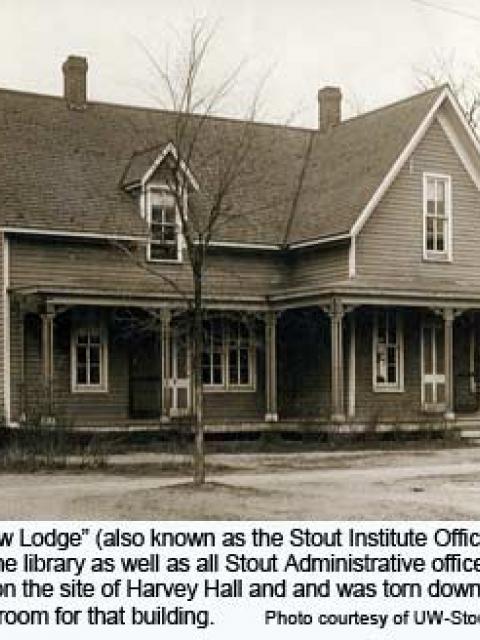
There was little need for an institutional library when the Stout Training School opened its doors in 1891. Textbooks and course materials were provided for the fifty-nine students by their instructors for a small fee. In addition, the nearby Mabel Tainter Free Library was open to the students and faculty and had a collection of nearly 3,000 volumes. However, within seventeen years the growth of the school began to dictate the need for a library. Student enrollment had climbed to over two hundred students. The recently incorporated Stout Institute expanded to the following divisions: the Stout Manual Training School, the Kindergarten Training School, the Training School for Domestic Science Teachers, the Training School of Manual Training Teachers, the School of Physical Culture, and the Homemaker's School. Clearly, there was a need to centralize the various departmental libraries.
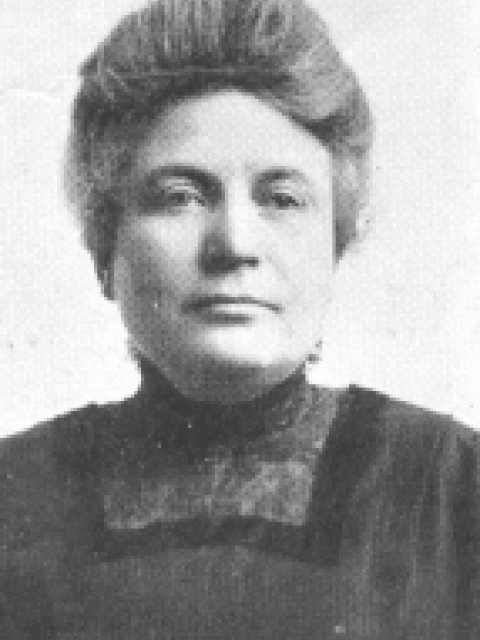
The origins of the library at Stout began in 1908 when Grace R. Darling arrived as an English teacher and as the first librarian. She was assigned a room in the "Yellow Lodge" (Harvey Hall) and equipped it with tables and chairs she "borrowed" from other departments. After rounding up the scattered books, the total number of volumes was 600.
Darling stayed on as a teacher at Stout, but after her first year, she was replaced by Stout's first full-time librarian, Katherine Hahn. Hahn came to Stout after graduating from the Library School of the University of Wisconsin in June 1909. It was under her leadership that the growth of the library collection had greatly accelerated. By June 1910, she reported that the library now contained 1,071 volumes and 3,172 pamphlets. Within two or more years the number of books nearly doubled, and Genevieve I. Field was hired as Hahn's assistant.
At that time, the library was maintained by a five dollars a year "library and reading room fee." The library itself was divided into three departments: Manual Training, Domestic Science, and Homemakers. One student, in a somewhat tongue-in-cheek manner, left the following description of the building:
"Three spacious rooms contain the literature of this institution of learning. These rooms sumptuously appointed with everything to make the erstwhile irksome task of studying an unalloyed joy. Shelves line the dignified walls and hold rare old copies of our greatest writer of Art and Science. A system of ventilation that is the acme of human ingenuity ensures a perfect circulation of air."

In 1914 the Yellow Lodge was torn down, and the library was moved to the Gymnasium-Natatorium Building. It was also at this time that the collection was classified under the Dewey Decimal System and a dictionary catalog was created with a complete index of the material in the library.
With the completion of the Home Economics Building (Harvey Hall) in 1916, the library found a home that it was to keep for nearly forty years. The Stout Annual for that year stated:
"Along the west side of the main floor extends the library with its fire-proof stack room, its special reference and conference room, magazine alcove and conveniently designed furnishings. The room is well lighted and well ventilated and large enough to accommodate nearly two hundred students. Another room on this floor is designed as a textbook room and has two delivery windows up on the main corridor."
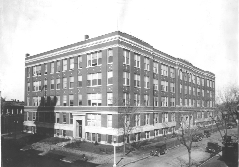 Harvey Hall Completed in 1916, the library moved into the west side of the main floor and stayed for nearly 40 years despite increasing severe space shortages. (Photo courtesy of UW-Stout Archives.)
Harvey Hall Completed in 1916, the library moved into the west side of the main floor and stayed for nearly 40 years despite increasing severe space shortages. (Photo courtesy of UW-Stout Archives.)
The library badly needed this increase in the size of accommodations. At the time of the move, the size of the collection had expanded to nearly 6000 volumes and 4000 pamphlets, with a growth rate of better than 10 % a year. It was unfortunate that Hahn had little time to enjoy the new facilities. Due to illness she resigned her position in November 1918 and died less than a year later. She had been popular with the students and had the 1915 Student Annual dedicated to her. The Stoutonia recorded, "Ten years ago Mrs. Hahn came to Menomonie to take charge of the Stout Institute Library. From that time to one year ago, her happy laugh and cheerful greeting made all who knew Mrs. Hahn find an added pleasure in frequent visits to the library."
Following the retirement of Mrs. Hahn, the library was to see a number of librarians in quick succession. Ottilie Liedloff finished Mrs. Hahn's last academic year and was herself replaced in the fall of 1919 by Ruth Tobey.
Tobey, a graduate of the University of Wisconsin Library School, served at Stout for two years before moving to Indiana." Margaret Gilpin, Tobey's replacement, served only one year before being replaced in turn by Marjorie Beal. Beal worked at Stout for nearly a year and a half before taking a job at the New York State Library in December 1923. Christine Halseth, the assistant librarian, assumed the duties of the librarian for the rest of the 1923-24 academic year. In fact, it was probably Halseth who ensured the smooth running of the library during this period of rapidly changing head librarians. Halseth prepared most of the annual reports and did many of the other jobs of the librarian as well, but may have lacked the formal education to head the department herself. She first came to Stout in 1913 after serving as an apprentice at the Mabel Tainter Memorial Free Library and was to stay at this institution until 1928.
--Kevin Thorie
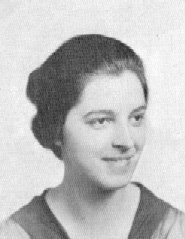
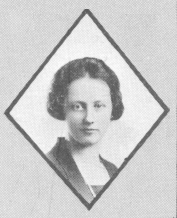
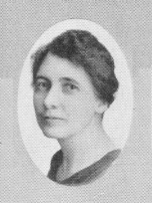
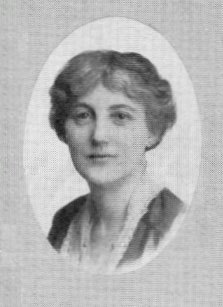
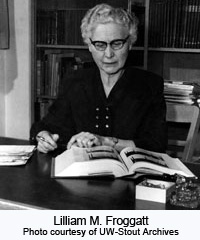
In 1924 Lillian M. Froggatt began her thirty-one-year term as head of the Stout Library. She had received her training at the University of Wisconsin and taught courses in library methods at the Oshkosh State Normal School prior to coming to Stout.
One of the first major problems Froggatt had to face in her new position was that of accreditation from the North Central Association. Stout certainly had an acceptable library when Froggatt arrived--close to 12,000 volumes for fewer than 600 students, but most of these were concentrated in the areas of industrial arts and household arts. North Central Association regulations stated that Stout had to have more books in the liberal arts areas. It was recognized that the Mabel Tainter Library did provide for many of these needs but that Stout should have its own as well. This was just one of the several difficulties that Froggatt had to handle before the library could be brought up to North Central Standards. Fortunately, one of the earliest results was that the library continued to pay for itself through a student fee ($3.50 per semester), but before Froggatt arrived, some of it was being siphoned off for other purchases. However, in 1927 Froggatt received permission to use all of the funds for the library's benefit."
In 1928 the North Central Association granted accreditation for Stout and Froggatt was allowed continued use of the money to improve the library's holdings. The broader base of the library combined with the creation of a department of liberal arts aided in Stout's being given full college rank and recognition by the North Central Association in 1932. The introduction of the graduate school in 1935 also led to the need for an increase in the holdings of the library.
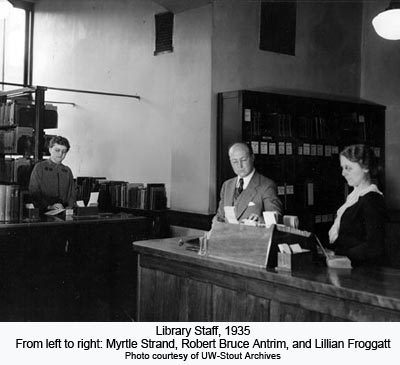
Other improvements were also made in the library at this time. In 1928 the library began to open evenings, and another staff member was added bringing the total to three. By 1923 the library was improved to such an extent that after inspecting Stout, Ed Horstad of the Drexel Institute said in a letter to President Burton E. Nelson, "I am taking the liberty of writing to you in regard to what I consider the most outstanding feature of the Stout Institute - the library."
--Kevin Thorie
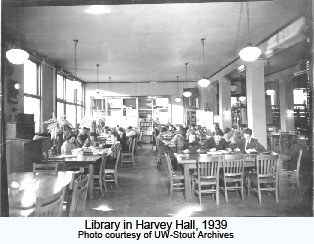
One problem that the library was not able to overcome at that time was student abuse of their library privileges. For years the library was "the place" to meet and was referred to in the 1936 Tower as "...a place of big dates and little books." A quote from a gossip column in the Stoutonia illustrates the problem, "My black dress did its duty again last night at the dating-bureau (sophisticated, not sophomore) name for the library." Consequently, the noise level was always high, which was exacerbated by the bare floors, and the fact that the general reading/study area was in the same room as the circulation desk. The problem became so acute in 1938 that the Library Committee, Student Activities Committee, and the Stout Student Association met. The result was prepared cards that informed noisy students that they couldn't come to the library for a week. Even this did not seem to help. This difficulty was only overcome when the student center was built in 1959.
The consistent increase in the size of the library was placing continued pressure on the physical plant. By 1940, Froggatt wrote to President Nelson that: "In response to your questions about the need for a library building, I should like to say that the library can accommodate normal additions in books for two years." She went on to explain that storage space was exhausted and that there was not enough room for readers.
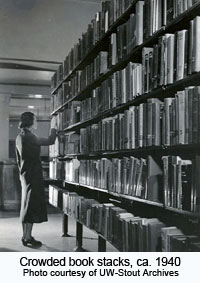 Although the need was there and steps were being taken for the construction of a new library building, immediate hopes were shelved when World War II began.
Although the need was there and steps were being taken for the construction of a new library building, immediate hopes were shelved when World War II began.
The Second World War had a sad personal note for the Stout library. Former assistant librarian, Robert Bruce Antrim, died while he was in the service. He had worked at Stout from 1928 to 1942 and seemed to have been a favorite among the students, as his name frequently appeared in the Stoutonia gossip columns.
By the end of the war, the library was at a saturation point. It now housed close to 30,000 volumes; better than 500% more than when it moved to Harvey Hall.
Assistant Librarian Beulah Howison (1942-1975) stated that conditions were such that "...if the library was the heart of the institution, it would have had a coronary." The process of making plans for a new library took much longer than the actual construction of the building. Fortunately, Froggatt's M.A. thesis had been written about how to build a library. Hundreds of questionnaires and plans were studied before the groundbreaking began to ensure that the library would meet the needs of the institution.
--Kevin Thorie
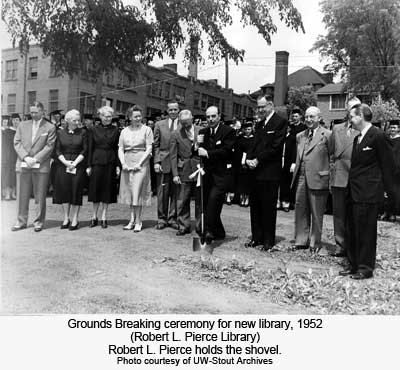
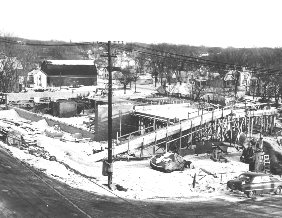
The dedication of the $600,000 new library occurred June 4, 1954. It was designed to house 107,000 volumes and had a main reading room seating capacity for 250 students. Special features in the library included seminar rooms, study carrels, a visual aids room, a recording and microfilm laboratory, and a typing room. The students did the actual transfer of books from Harvey Hall to the new structure. On "M" day, March 9, of the same year, classes were closed, and Stout students and staff moved approximately 40,000 volumes to their new location.
In 1960 the library building was named after Robert L. Pierce. Pierce was a well-known resident of Menomonie who had spent twelve years on the Board of Regents and was also a member of Stout's governing board for twenty-one years. He died in 1968.

During the cold war years, the library had encounters with censorship. In 1949 Chairman John S. Wood of the House Committee for Un-American Activities wanted Stout to furnish his committee with a list of all the textbooks on campus. President Fryklund immediately complied with the request, but following an uproar against censorship throughout the country, no further requests were made at Stout or other institutions of higher education.
However, President Fryklund attempted to influence library and textbook purchases by asking to approve all textbook purchases and suggesting the library purchase a number of anti-Communist books. Regarding textbook purchases, he writes to Ms. Froggatt, "Another example - I have disapproved one book on Philosophy of education because I happen to know that the author of the book is just too "red" and he [sic] can read borderline thoughts in his writings.
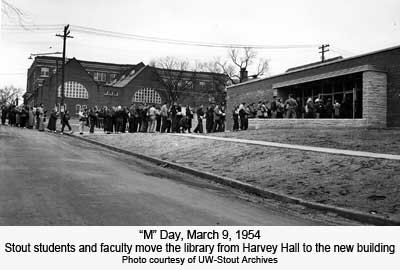 One year after the completion of the new library building, Lillian Froggatt retired from Stout as Faculty Emeritus. She spent the following years traveling and as an active member in several clubs in Menomonie. Following her death after a tragic car accident in 1969, Dr. John Jarvis, Vice President for Academic Affairs at Stout, stated: "She was the most conscientious person I've ever known. She dropped everything she was doing to help you in the library."
One year after the completion of the new library building, Lillian Froggatt retired from Stout as Faculty Emeritus. She spent the following years traveling and as an active member in several clubs in Menomonie. Following her death after a tragic car accident in 1969, Dr. John Jarvis, Vice President for Academic Affairs at Stout, stated: "She was the most conscientious person I've ever known. She dropped everything she was doing to help you in the library."
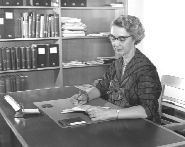 Phyllis Bentley was promoted to head the library in 1955. She had come to Stout a year earlier as an assistant librarian. Prior to that, she had worked at Beloit College and the Mankato State Teacher's College.
Phyllis Bentley was promoted to head the library in 1955. She had come to Stout a year earlier as an assistant librarian. Prior to that, she had worked at Beloit College and the Mankato State Teacher's College.
She received her B.A. from the University of Wisconsin and her M.S. from the Columbia University School of Library Science.
--Kevin Thorie
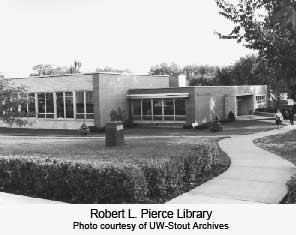
A recurring problem that the new library had to face was the student demand to increase the number of hours it was open. For years there was a struggle between the student and the administration with the library caught in-between. In 1957 Stout's Library ranked first in the State College System in terms of being available to students, but by 1974 it fell to eleventh place out of thirteen when the hours were cut back because of a reduction in funding. Student reaction against this was instantaneous, and a sit-in was proposed. Bowing to pressure, the funding was restored, and the library resumed its regular hours.
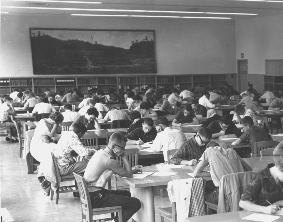 Another difficulty the library had to meet was the increasing loss of books and magazines. This had been a problem since the library was first established. In 1960 Bentley proposed that a series of checkpoints be created so that patrons could be checked before leaving the library.
Another difficulty the library had to meet was the increasing loss of books and magazines. This had been a problem since the library was first established. In 1960 Bentley proposed that a series of checkpoints be created so that patrons could be checked before leaving the library.
Subsequently, turnstiles were installed, and people were asked not to take their coats and briefcases into the stacks. This may have slowed the theft of materials, but it did not stop it. In addition, it created a sense of hostility between the patrons and the checkers. By 1978 it was estimated that $200,000 worth of material had been stolen since the founding of the library. In that same year, the electronic security system was installed, and losses were cut significantly.
When the new building was completed in 1954 it was expected to house the library for fifty years At that time no one had foreseen the tremendous growth that would occur at Stout and the resulting expansion of the library. A stopgap measure was initiated by building an addition onto the library, but it was recognized that an entirely new facility would have to be built. In fact, a considerable controversy went on as to the advisability of expansion because of architectural difficulties; however, the Board of Regents ruled against a new library building at that time.
--Kevin Thorie
Construction of the new addition began in 1968 and ended two years later. The 1.2 million-dollar facility provided additional seating space for about seven hundred students and library space for an additional ninety thousand volumes.
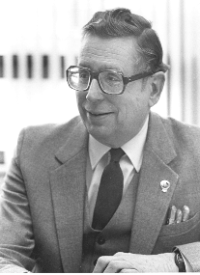 Soon after the completion of the new addition, an important administrative change occurred when longtime Stout faculty member Dr. David P. Barnard was named Dean of Learning Resources. This resulted in the library and audiovisual services being combined with a name change for the library to Media Retrieval Services-Pierce Library.
Soon after the completion of the new addition, an important administrative change occurred when longtime Stout faculty member Dr. David P. Barnard was named Dean of Learning Resources. This resulted in the library and audiovisual services being combined with a name change for the library to Media Retrieval Services-Pierce Library.
There were other important changes, as well. In 1969 an Educational Materials Center (EMC) was created following a recommendation from the National Council for Accrediting Teacher Education. Brooke B. Anson was hired to develop the EMC, a position he assumed until he was named Coordinator of Public Services in 1975, following the retirement of Beulah C. Howison after 33 years of service. Two years later through joint efforts of the State Historical Society, the Dunn County Historical Society, and the library; an Area Research Center was added. Gayle Martinson became Stout's first full-time University Archivist/ARC Coordinator in 1978.
 The rental Textbook Service again became an administrative responsibility of the Pierce Library on December 1, 1975, after being operated by Administrative Services for a number of years. With the appointment of Brenda Bley in 1977 as Textbook Service manager, a name change to Rental Resource Services was approved.
The rental Textbook Service again became an administrative responsibility of the Pierce Library on December 1, 1975, after being operated by Administrative Services for a number of years. With the appointment of Brenda Bley in 1977 as Textbook Service manager, a name change to Rental Resource Services was approved.
In 1971 Bentley retired. During her seventeen years at Stout, the library doubled in size. John Joseph Jax became the next director of the library. Jax came to Stout as an instructor and assistant librarian in 1959. He had received his B.A. from La Crosse and his M.S. in Library Science from Madison.
Jax reorganized the library by naming Beulah E. Howison as Coordinator of Public Services, Mary R. Donley as Coordinator of Technical Services, and Philip J. Schwarz as Special Assistant for Automation. In 1973, an integrated audiovisual, printed resources concept was introduced. Audiovisual resources were cataloged, shelved, and circulated together with print resources. This was a new concept for a college library initiated by Dean Barnard in 1970. Film rental and micrographics services were assumed as library responsibilities during the early 1970s.
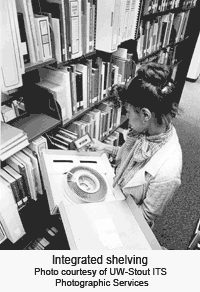 In recent years technology has played an increasingly vital role at the Stout library. Automation not only makes the librarian's job easier in finding and providing material for users, but it also aids in problems of storage through micrographics and other procedures. The simple addition of the first Xerox machine for student use in 1966 changed dramatically the capabilities of the library.
In recent years technology has played an increasingly vital role at the Stout library. Automation not only makes the librarian's job easier in finding and providing material for users, but it also aids in problems of storage through micrographics and other procedures. The simple addition of the first Xerox machine for student use in 1966 changed dramatically the capabilities of the library.
In 1967 under the leadership of Dean Robert S. Swanson of the Graduate College and with the aid of a grant from the United States Office of Education to study the substantive Library holdings of industrial education, the computer was first introduced at Stout. A key-punch, collator, sorter, printing/accounting machine and two staff members, Ed Lund, programmer, and Bonnie Christianson, keypunch operator were acquired to establish a machine-readable database for library holdings. A Computer Output Microfiche (COM) public catalog was produced in 1974 and placed in faculty offices and residence halls. With Philip Schwarz's appointment as special assistant for automation in 1973, Stout library automation progressed with numerous Keyword Out of Text (KWOC) indices to special collections. In 1982, Stout acquired the first truly integrated automated library information system in the UW-System and became one of the few libraries in the nation as a whole, possessing such a system.
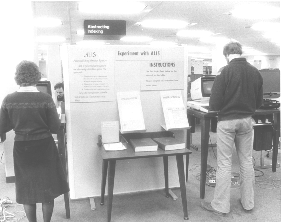
The role of the staff also changed with the growth of the library and the introduction of automation. Staff members had to become more specialized in areas of the new technology while maintaining their basic library expertise. In some cases, grants had to be received to enable the librarians to understand for themselves how the new technology could be used. With that understanding, they had to increase their roles as teachers to show students and faculty members how to use the new services.
Staff members participated in projects outside of the library as well. From 1977-1980, the Stout library served as a lead institution in developing a new library for the Institute of Electronics and Electricity in Boumerdes, Algeria. John J. Jax, library director, made several trips to Algeria to coordinate development. Key library personnel were involved in acquiring more than $648,000 worth of library resources, which were cataloged and processed at Stout and shipped to Algeria.
By the mid-seventies, it was apparent that a new building was needed for the library. Lack of space had again become a problem, but there were other factors as well. Temperatures could not be controlled and that affected audiovisual equipment and paper fife. The layout was also awkward in that some sections had to be split and placed in different areas of the library. Planning to construct the new building took years, but it was not until September 1978 that the building was approved. In July 1979, actual construction began on what was to become the new Library Learning Center (a name change from Media Retrieval Services to the Library Learning Center was formally approved on June 13, 1983, by action of the West Central Wisconsin Consortium).
--Kevin Thorie

The Library Learning Center received a special honor in 1983. The Wisconsin Library Association gave its Clarence B. Lester "Library-of-the-Year" award to Stout's Library Learning Center during the WLA annual conference held in Appleton. Many of the Stout Library Learning Center staff were present to receive the award. The citation reads as follows:
"For its outstanding service to students and faculty as an academic library in the University of Wisconsin system;
For its continued support of excellence and its forward approach in the use of education technology;
For providing ease of access to information with the total integration of print and multimedia material;
For its commitment to interlibrary cooperation on the local, state and regional levels;
For developing a Rental Resource Service, in cooperation with the faculty, as an innovative approach to classroom instruction;
For its extensive use of automation in support of users' services, including the free use of microcomputers;
For its encouragement of the staff development and its professional leadership at the state, national and international level;
For the design of a new library learning center which incorporates the latest technology developments and offers outstanding innovation to its patrons;
For its quality service to the University, to the residents of Dunn County and other Wisconsin citizens, the Wisconsin Library Association is proud to present the 1983 Clarence B. Lester Memorial Award to the Library Learning Center, University of Wisconsin-Stout."
Three years later, in 1986, the library received another honor when its director John J. Jax was named Librarian of the Year by the Wisconsin Library Association. Jax was specifically commended for advancing new technology at Stout's facility as well as for his international library activities in Algeria. The library received additional honors shortly after when it received the University of Wisconsin System's "Center of Excellence Award."
A major change in leadership for the library began when Dean David Barnard announced his retirement in 1987. Barnard, a member of the Stout faculty for 41 years, had been the first dean of the School of Learning Resources. Among his many accomplishments were the creation of the Teleproduction Center, organizing the Media Technology Conference, developing the Media Technology Department and Instructional Technology Services, and development of the university's graduate program in media technology. He also played a key role in the creation of the new library building. In 1984, he had been named "Administrator of the Year" by the Wisconsin Educational Media Association.
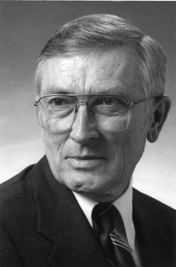 Following a nation-wide search, Dr. Harry Herbert was named as the new dean of the School of Learning Resources. Herbert had been on the staff at Stout since 1965. He received a bachelor's degree from Bowling Green University, a master's from Stout, and his Ed.D from Indiana University. Before becoming dean, Herbert had been the director of Instructional Technology Services and assistant dean of Learning Resources.
Following a nation-wide search, Dr. Harry Herbert was named as the new dean of the School of Learning Resources. Herbert had been on the staff at Stout since 1965. He received a bachelor's degree from Bowling Green University, a master's from Stout, and his Ed.D from Indiana University. Before becoming dean, Herbert had been the director of Instructional Technology Services and assistant dean of Learning Resources.
Members of the library staff had to face a major crisis when a fire broke out in Ray Hall in September of 1987: the home of Rental Resources. The fire, originating in one of the art department studios, raged for over an hour before firefighters brought it under control. Disaster recovery began immediately through the efforts of library staff members as well as from the campus community. Water damage to textbooks was the main problem faced by rental resources. Thanks to quick action, most of the books and resources were saved, and total costs to the library were kept to under $9,000.
It was shortly after the fire that the library entered into the Consortium of Hospitality Research Information Services (CHRIS). In addition to Stout, charter consortial members were Cornell University, Purdue University, and the American Hotel and Motel Association. CHRIS was founded to develop both printed and electronic bibliographic database access to hotel, motel, restaurant, travel, convention, and related hospitality publications. The Stout library continued its participation in this program for eight years.
In 1989, the library installed its second on-line Public Catalog System (PubCat, LS2000). PubCat was the computer system used by most of the other universities in the University of Wisconsin System. One advantage of PubCat over ALIS was its ability to keyword search for a subject rather than finding a word that the computer is familiar with. This would continue to be the library's online system until the NOTIS upgrade in late 1993.
Following a reorganization of the university's governing structure, the School of Learning Resources was disbanded in 1990. The library became an independent unit with the director reporting directly to the provost's office. Dean Harry Herbert retired.
The fastest growing bodies of students at Stout in the early "Nineties" were those with disabilities. Even before the passing of the Americans with Disabilities Act, the library was user-friendly for the physically handicapped. In addition to being barrier-free, the Adaptive Technology Area of the library provided machines that allowed material to be magnified several times its normal size. Other devices, such as the Arkenstone and Kurzweil Readers, would scan written words and convert them into audible words. Through the years the library has received funding from several grants to help cover the costs of this equipment.
--Kevin Thorie
Throughout the decade of the Nineties, the library, like the rest of the university had to face the problem of budget cuts. The budget for the purchase of books, magazines and other forms of media has often been frozen or even cut. Due to inflation, the loss of purchasing power has often led to a loss of journal titles. To add to the problem, the library must also pay tens of thousands of dollars each year for databases that are deemed essential now but were not even in existence ten years ago. One way in which the library has been attempting to cope with this is by forming a consortium with the other University of Wisconsin System libraries to enhance purchasing power.
A second way in which the library has found help in dealing with the budget crunch is through grants and gifts. For example, the Rakstis Endowment Fund gave $50,000 to the library to fund acquisitions of manufacturing engineering resources. The David P. Bamard Family Endowment, presented by David and Kathleen Bamard, provided much-needed funding for staff development. There have also been numerous grants given to the library's staff for new computers, machines to help the disabled, microfilm copy machines, scanning machines, and other equipment. Two grant proposals were also successfully awarded to enable the library to implement full-text information delivery for faculty and students. Student Technology Fees have added further funding for computers and related technologies.
 Following a $248,000 remodeling project, Instructional Resources Service (IRS), formerly Rental Resources Services, left Ray Hall and moved into the Library Learning Center building in 1996. IRS is now housed in what previously had been the second-floor computer lab, academic skills center study rooms, and library conference room. A second major project, costing close to $225,000, began later that year to improve air quality.
Following a $248,000 remodeling project, Instructional Resources Service (IRS), formerly Rental Resources Services, left Ray Hall and moved into the Library Learning Center building in 1996. IRS is now housed in what previously had been the second-floor computer lab, academic skills center study rooms, and library conference room. A second major project, costing close to $225,000, began later that year to improve air quality.
When the Stout library first opened its doors in the Yellow Lodge ninety years ago, perhaps the one word that would best describe what it was about is "books." Today that word would be "technology." As the library approaches the new millennium technology affects all aspects of its operation. Reference librarians are much more likely to refer a user to an electronic format rather than a paper one. Instead of talking about the Library of Congress method of classifying and cataloging books, library instructors are teaching how to search the World Wide Web and the Internet. Instruction itself has changed from teaching in a crowded room to hands-on experience in an enlarged and technologically enhanced library instruction lab that opened in 1998.
It will be interesting to see what lies in store for the Stout library in the Twenty-First Century. Already there are several indicators. At the circulation desk, a student could ask to check out a laptop computer or a digital camera rather than a book. The original twenty dumb terminals that replaced the card catalog have in turn been replaced by approximately 150 personal computers with capabilities that few people even envisioned ten years ago. The number of off-campus patrons in such areas as reference and instructional resource services will continue to increase, as distance education grows in popularity. The future of the library cannot be known, but it is strongly believed that quality service and dedicated employees will continue to be the tradition in the "heart of the institution."
--Kevin Thorie
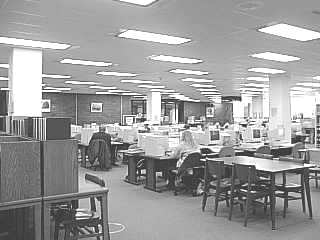
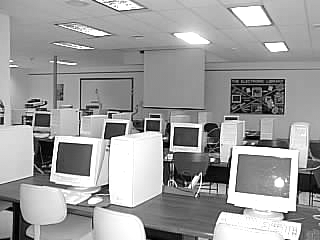
1 Dwight L. Agnew, "A History of Stout State University (1893-1966)," in Walker D. Wyman, ed., History of the Wisconsin State Universities (River Falls, Wis.: River Falls University Press, 1968), p. 245.
2 Stoutonia (Menomonie, Wis.), January 31, 1917, p. 1, col. 1.
3 Stoutonia (Menomonie, Wis.), October 16, 1919, p. 1, col. 1.
4 Library Report for 1910. Media Retrieval Services. Subject and Correspondence File, 1903-1971. Stout Series 9, Box 1, Folder 7. University of Wisconsin-Stout Area Research Center.
6 Report of the Librarian for 1910-1911. Chancellor's Office. Subject and Correspondence File, 1896-1983. Stout Series 24, Box 68, Folder 1, University of Wisconsin-Stout Area Research Center.
7 Stout Annual, 1914, p. 75. Tower Yearbook. The Tower, 1909. Stout Series 15, Box 1, Folder 6, University of Wisconsin-Stout Area Research Center.
8 Report of the Librarian for 1913-1914. Chancellor's Office. Subject and Correspondence File, 1896-1983. Stout Series 24, Box 68, Folder 1, University of Wisconsin-Stout Area Research Center.
9 Stout Annual, 1917, p. 100. Tower Yearbook. The Tower, 1909. Stout Series 15, Box 2, Folder 3, University of Wisconsin-Stout Area Research Center.
10 Stoutonia (Menomonie, Wis.), October 9, 1919, p. 1, col. 2 and October 16, 1919, p. 1, col. 1.
11 Stoutonia (Menomonie, Wis.), September 29, 1922, p. 3, col. 3.
12 Stoutonia (Menomonie, Wis.), December 21, 1923, p. 2, col. 1.
13 Letter from President B.E. Nelson to Lillian Froggatt, September 11, 1927. Chancellor's Office. Subject and Correspondence File, 1896-1983- Stout Series 24, Box 67, Folder 6, University of Wisconsin-Stout Area Research Center.
14 Agnew, op. Cit., p. 259.
15 Letter from Ed G. Hostad to President Burton E. Nelson, November 30, 1930. Chancellor's Office. Subject and Correspondence File, 1896-1983. Stout Series 24, Box 67, Folder, University of Wisconsin-Stout Area Research Center.
16 The Tower, 1936, p. 107. Tower Yearbook. The Tower, 1909. Stout Series 15, Box 5, Folder 4, University of Wisconsin-Stout Area Research Center.
17 Stoutonia ( Menomonie, Wis.), October 6, 1933, p. 2, col. 3.
18 Letter from Lillian Froggatt to President B.E. Nelson, December 17, 1940. Chancellor's Office. Subject and Correspondence File, 1896-1983. Stout Series 24, Box 67, Folder 8, University of Wisconsin-Stout Area Research Center.
19 Statement by Beulah C. Howison, former Librarian in an interview conducted by John J. Jax on April 23, 1981. A.R.C. Tape 15. Oral History Tape in the University of Wisconsin-Stout Area Research Center.
20 Dunn County News (Menomonie, Wis.), May 26- 1954, p. 1, col. 1.
21 Letter from John S. Wood to President Verne C. Fryklund, June 3, 1949. Chancellor's Office. Subject and Correspondence File, 1896-1983. Stout Series 24, Box 67, Folder 10, University of Wisconsin-Stout Area Research Center.
22 Letter from President Verne C. Fryklund to Lillian Froggatt, July 5, 1951. Chancellor's Office. Subject and Correspondence File, 1896-1983. Stout Series 24, Box 67, Folder 10, University of Wisconsin-Stout Area Research Center.
23 Stoutonia (Menomonie, Wis.), May 2, 1969, p. 1, col. 1.
24 Stoutonia (Menomonie, Wis.), September 19, 1974, p. 1, col. 1.
25 Stoutonia (Menomonie, Wis.), September 7, 1978, p. 4, col. 1.
26 Statement by Beulah C. Howison, former Librarian in an interview conducted by John J. Jax on April 23, 1981. A.R.C. Tape 15. Oral History Tape in the University of Wisconsin-Stout Area Research Center.
27 Stout Alumnus, Spring 1970, p. 7. University News Services. Stout Alumnus, 1926. Stout Series 21, Box 1, Folder 18. University of Wisconsin-Stout Area Research Center.
--Kevin Thorie
An ultra-modem barrier-free, five-story Library Learning Center was first occupied in January 1982. Cost of the facility was $6.7 million. The total building consists of 123,000 square feet with seating for 1,086 users and space for 400,000 volumes. Eight major functions were originally planned for Library Learning Center Library; Area Research Center; Micrographics Laboratory; Media Self-Instruction Laboratory; Campus Computing Laboratory; Academic Skills Center; teaching facilities for the Media Technology department, and an office for the Dean of Learning Resources.
Since the Facility was occupied in 1982, and up to the time of this writing (seventeen years later), much change and evolvement have occurred. The Media-Self-Instruction Lab, Academic Skills Center, and Campus Computing have moved elsewhere on campus. The Dean of Learning Resources position has been abolished. In May 1996, Instructional Resource Services (rental/textbooks) moved to a newly remodeled area on the second floor, formerly occupied by the Academic Skills Center and Media Self-Instruction Laboratory. This brought together all service units of the Library Learning Center under one roof. In 1997-1998, a major remodeling and heating, ventilation and air conditioning project brought improved building air quality and an enlarged Library Instruction Lab on the first floor. The former technical services area moved to the fifth floor into an area previously occupied by the Campus Computing Lab. Group study rooms on each floor were converted to library staff offices, and the study rooms moved to the first floor (former staff) offices.
Interlibrary Loan and the Periodicals Unit were relocated on the first floor. The campus Budget Planning and Analysis unit now is located on the second floor west, formerly the Dean of Learning Resources suite.
The late 1980s and all through the 1990s saw tremendous electronic and digital technological advances in the library. From 1986-1999, three automated computer systems were acquired (LS2000, NOTIS, and Endeavor Voyager). The library's first automated system was acquired in 1982, making a total of four systems in seventeen years. Optical scanners, full-text databases, Digital LCD (Liquid Crystal Display) presentation units and hundreds of microcomputers were purchased. A public access print management system was developed and installed in 1998. A big change has been noted with more users accessing library information remotely (out of the building) than ever before. This trend will continue.
A new Library Learning Center organizational model was introduced in January 1996. The new restructure evolved after a fifteen-month review by eight elected library staff members, comprising academic staff, classified, library faculty, and the library director. The new model, which focuses on working groups rather than a pyramidal decision-making structure, was strongly endorsed by the staff.
The Library Learning Center continues to have individuals who are committed to serving students, faculty, and staff and dedicated to enhancing users' lifelong learning skills.
--John Joseph Jax
| Head Librarian/Library Directors | |
| Year | Name |
| 1908-09 | Grace R. Darling |
| 1909-18 | Katherine Hahn |
| 1918-19 | Ottilie Liedloff |
| 1919-21 | Ruth Tobey |
| 1921-22 | Margaret Gilpin |
| 1922-23 | Marjorie Beal |
| 1923-24 | Christine Halseth (Acting) |
| 1924-55 | Lilian Froggatt |
| 1955-71 | Phyllis Bentley |
| 1971-03 | John J. Jax |
| 2003-05 | Philip J. Schwarz |
| 2005-06 | Brenda Swannack (Interim) |
| 2006-2011 | Paul Roberts |
| 2011- | William Johnston (Interim) |
| Library Locations/ Names | |
| Year | Location/Name |
| 1893 | Mabel Tainter Memorial Library |
| 1908 | Yellow Lodge |
| 1914 | Gymnasium-Natatorium Building |
| 1916 | Harvey Hall |
| 1954 | Robert L. Pierce Library |
| 1982 | Library Learning Center |
| 2007 | University Library in Robert S. Swanson Learning Center |




